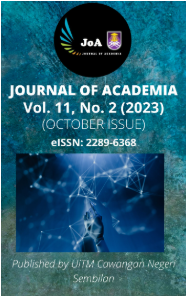REVEALING STUDENTS’ EMOTIONAL ENGAGEMENT IN CLASS: AN ONLINE DISTANCE LEARNING (ODL) PERSPECTIVES
Keywords:
Emotional engagement, Online Distance Learning (ODL), Students’ engagementAbstract
Online Distance Learning (ODL) is a prominent method used in conducting online class for institutions of higher learning (IHLs) in Malaysia since COVID-19 pandemic. Therefore, it is vital to understand students’ emotional engagement during online class to improve learning. This study focuses on university’s students’ preference in participating during online class and their emotional reactions by identifying their positive or negative feelings toward online class participation. A quantitative method was used and questionnaire was addressed to 163 Information Science Studies students from College of Computing, Informatics and Mathematics, Universiti Teknologi MARA (UiTM) Negeri Sembilan Branch, Rembau Campus. The results showed that 65.6% of students prefer to participate actively during online class with positive feelings as revealed by the study where 17.8% students enjoy being acknowledged and feels appreciated if lecturer call upon their name in class to share their opinions and ideas or answer questions given to them. In addition, 14% students stated this action can boost their confidence and enhance their communication skills. These findings are in line with previous research that showed interpersonal relationships and interaction between students and lecturers have a pivotal role in inducing students’ confidence and involvement. Active communication between lecturers and students can promotes students’ sense of belonging which make them more interested in capturing the information and knowledge convey in class. Hence, the findings may spark interests for lecturers or educators to engage students learning so active learning session can be developed and benefits both parties. Thus, may give positive influence on lecturers-students relationship.
References
Bryson, C., & Hand, L. (2007). The role of engagement in inspiring teaching and learning. Innovations in Education and Teaching International, 44(4), 349-362.
Chadda, I., & Kaur, H. (2021). COVID pandemic and virtual classes: A Study of students from Punjab. Asian Association of Open Universities Journal, 16 (2), 193-210. https://doi.org/10.1108/AAOUJ-02-2021-0017
Dahleez, K.A., El-Saleh, A.A., Al Alawi, A. M, & Abdelfattah, F.A. (2021). Higher education student engagement in times of pandemic: The role of e-learning system usability and teacher behavior. International Journal of Educational Management, 35(6), 1312-1329. https://doi.org/10.1108/IJEM-04-2021-0120
Gunuc, S. & Kuzu, A. (2014). Student engagement scale: Development, reliability and validity. Assessment & Evaluation in Higher Education, 40(4), 587-610.
Gunuc, S. (2014). The Relationships between student engagement and their academic achievement. International Journal on New Trends in Education and their Implications, 5(4), 216-231.
Gupta, K.P. (2022). Exploring student engagement in virtual classrooms: A person-centred approach using cluster analysis. International Journal of Educational Management, 37(1), 117-134. https://doi.org/10.1108/IJEM-08-2022-0309
Harris, L., Dargusch, J., Ames, K., & Bloomfield, C. (2022). Catering for ‘very different kids’ : Distance education teachers’ understandings of and strategies for student engagement. International Journal of Inclusive Education, 26(8), 848-864.
Malaysian National Security Council. (2020). Movement control order. https://covid-19.moh.gov.my/faqsop/faq-umum/1.%20FAQ%20MKN_17%20Mac%202020.pdf. [Access online 30 July 2023].
Nikou, S., & Maslov, I. (2021). An analysis of students’ perspectives on e-learning participation – The case of COVID-19 pandemic. The International Journal of Information and Learning Technology, 38(3), 299-315. https://doi.org/ 10.1108/IJILT-12-2020-0220
Pietarinen, J., Soini, T., & Pyhältö, K. (2014). Students’ emotional and cognitive engagement as the determinants of well-being and achievement in school. International Journal of Educational Research, 67, 40-51. https://doi.org/ 10.1016/j.ijer.2014.05.001
Wang, M., & Holcombe, R. (2010). Adolescents perceptions of school environment, engagement and academic achievement in middle school. American Educational Research Journal, 47, 633-662.
You, S. (2011). Peer influence and adolescents’ school engagement. Procedia - Social and Behavioral Sciences, 29. 829-835. https://doi.org/ 10.1016/j.sbspro.2011.11.311
Van Uden, J.M., Ritzen, H., & Pieters, J.M. (2014). Engaging students: The role of teacher beliefs and interpersonal teacher behavior in fostering student engagement in vocational education. Teaching and Teacher Education, 37, 21-32.
Downloads
Published
Issue
Section
License
Copyright (c) 2023 Journal of Academia

This work is licensed under a Creative Commons Attribution-NonCommercial-NoDerivatives 4.0 International License.












